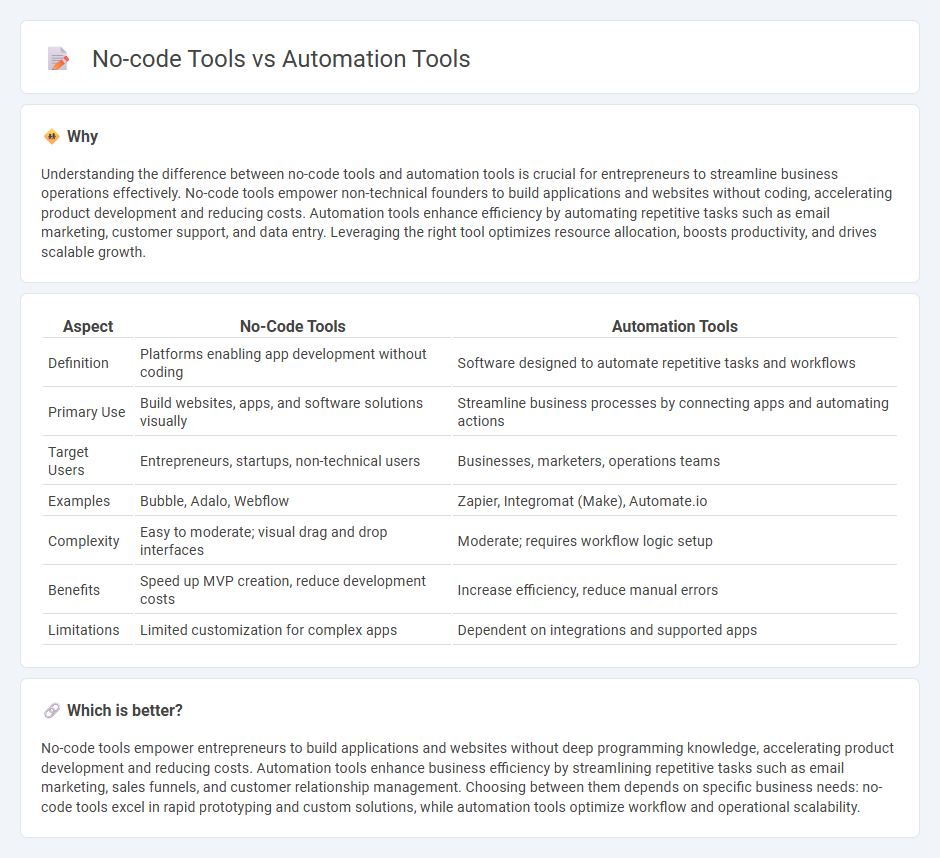
No-code tools empower entrepreneurs to build applications and workflows without writing code, accelerating product development and reducing reliance on technical resources. Automation tools streamline repetitive business processes by integrating software applications, enhancing operational efficiency and allowing focus on strategic growth. Explore how combining no-code and automation tools can transform your entrepreneurial journey and scale your business faster.
Why it is important
Understanding the difference between no-code tools and automation tools is crucial for entrepreneurs to streamline business operations effectively. No-code tools empower non-technical founders to build applications and websites without coding, accelerating product development and reducing costs. Automation tools enhance efficiency by automating repetitive tasks such as email marketing, customer support, and data entry. Leveraging the right tool optimizes resource allocation, boosts productivity, and drives scalable growth.
Comparison Table
| Aspect | No-Code Tools | Automation Tools |
|---|---|---|
| Definition | Platforms enabling app development without coding | Software designed to automate repetitive tasks and workflows |
| Primary Use | Build websites, apps, and software solutions visually | Streamline business processes by connecting apps and automating actions |
| Target Users | Entrepreneurs, startups, non-technical users | Businesses, marketers, operations teams |
| Examples | Bubble, Adalo, Webflow | Zapier, Integromat (Make), Automate.io |
| Complexity | Easy to moderate; visual drag and drop interfaces | Moderate; requires workflow logic setup |
| Benefits | Speed up MVP creation, reduce development costs | Increase efficiency, reduce manual errors |
| Limitations | Limited customization for complex apps | Dependent on integrations and supported apps |
Which is better?
No-code tools empower entrepreneurs to build applications and websites without deep programming knowledge, accelerating product development and reducing costs. Automation tools enhance business efficiency by streamlining repetitive tasks such as email marketing, sales funnels, and customer relationship management. Choosing between them depends on specific business needs: no-code tools excel in rapid prototyping and custom solutions, while automation tools optimize workflow and operational scalability.
Connection
No-code tools empower entrepreneurs by enabling rapid development of applications without extensive programming knowledge, accelerating the validation and launch of business ideas. Automation tools seamlessly integrate with no-code platforms to streamline repetitive tasks, enhancing operational efficiency and reducing manual workloads. Together, these technologies foster agile entrepreneurship by lowering technical barriers and optimizing workflow management.
Key Terms
Workflow Optimization
Automation tools streamline repetitive tasks by integrating multiple systems and enabling custom workflows, improving overall efficiency in business operations. No-code tools empower users without programming skills to design and deploy automated workflows through intuitive drag-and-drop interfaces, accelerating digital transformation. Explore how combining automation and no-code solutions can revolutionize your workflow optimization strategies.
Customization
Automation tools offer extensive customization through scripting and integration capabilities, enabling complex workflows tailored to specific business needs. No-code tools prioritize ease of use with drag-and-drop interfaces but often have limitations in customization and flexibility compared to automation platforms. Explore detailed comparisons and case studies to determine which option best fits your workflow requirements.
Technical Barrier
Automation tools often require programming knowledge and technical expertise to design complex workflows, making them less accessible to non-developers. No-code tools eliminate these barriers by providing intuitive visual interfaces that allow users to build applications and automations without writing code. Explore the key differences and advantages of each to determine which fits your technical capacity and business needs.
Source and External Links
The 30 Best AI Automation Tools (+ How to Use to Improve ...) - This resource categorizes top AI automation tools for 2025 by use case, highlighting tools like Power Automate for Microsoft workflows, UiPath for enterprise automation, ChatGPT for conversational AI, and Asana for project management.
The Top 10 Test Automation Tools of 2025 - Lists leading test automation tools including Microsoft RSAT, Selenium, Katalon, and Keysight Eggplant, focusing on features like no-code automation, test coverage across platforms, and CI/CD integration.
Top 16 Automation Testing Tools For 2025 - Details Katalon as a top AI-powered test automation tool supporting UI and API testing across web, mobile, and desktop without coding, along with other popular options like Selenium and Appium.
 dowidth.com
dowidth.com